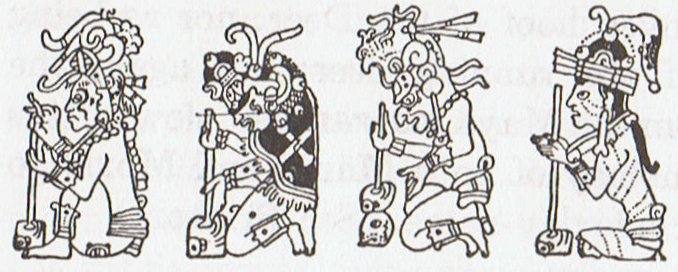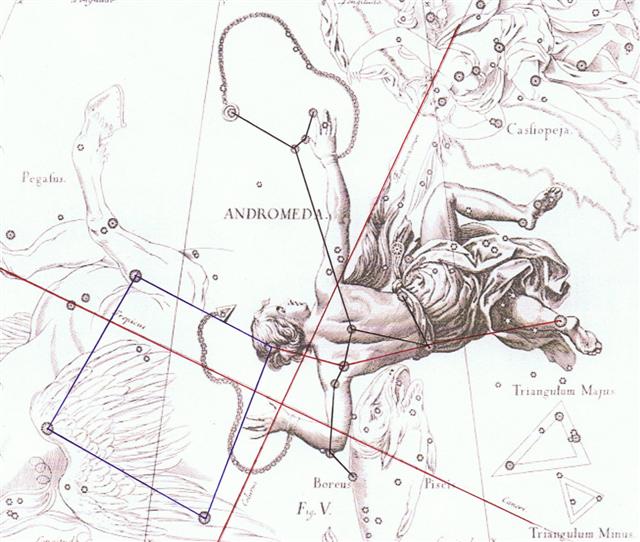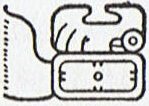3. In spring the 'head' in the sky evidently is in the focus of interest - its presence is necessary for the growth in the fields. But 'kaff' in Kaffaljidhma does not mean literally 'head': "The Arabian astronomers of course knew the Greek constellations and called it [Cetus] Al Ketus, from which have come Elketos, Elkaitos, and Elkaitus; but their predecessors, who had not heard of the Royal Family and its foe, separated these stars into three very different asterisms. Those in the head, α, γ, δ, λ, μ, ξ¹and ξ² , were Al Kaff al Jidmah, the Part of a Hand, from a fancied resemblance to their Stained Hand, our Cassiopeia ..." (Allen) ... the early Arabs had a very different figure here, in no way connected with the Lady as generally is supposed, - their Kaff al Hadib, the large Hand [cfr Caph] Stained with Henna, the bright stars marking the fingertips; although in this they included the nebulous group in the left hand of Perseus. Chrysococca gave it thus in the Low Greek Χείρ βεβαμένη; and it sometimes was the Hand of, i.e. next to, the Pleiades ... Evidently at least three different meanings adhere to kaff: 1) head, 2) hand, and 3) next to. By looking at the hand of Andromeda we can see a possible link, because her thumb (a part of the hand) is located (according to Hevelius) next to where the agricultural year is being born (= its 'head):
A daughter should be a copy of her mother: ... After Hotu's canoe had anchoraged, the child of Vakai and Hotu appeared. It was Tuu Maheke, son of Hotu, a boy. After the canoe of Ava Rei Pua had also arrived and anchoraged, the child of Ava Rei Pua was born. It was a girl named Ava Rei Pua Poki ... The Ram is another 'head' constellation, and we should also remember Medusa, whose head Perseus used to turn the sea monster into stone: ... This constellation [Cetus] has been identified, at least since Aratos' day, with the fabled creature sent to devour Andromeda, but turned to stone at the sight of the Medusa's head in the hand of Perseus ... The one-eyed cyclope Polyphemus was the lord of Medusa: ... Odysseus and his fleet were now in a mythic realm of difficult trials and passages, of which the first was to be the Land of the Cyclopes, 'neither nigh at hand, nor yet afar off', where the one-eyed giant Polyphemus, son of the god Poseidon (who, as we know, was the lord of tides and of the Two Queens, and the lord, furthermore, of Medusa), dwelt with his flocks in a cave ... We know how the head of king Hotu Matua ended up in a hole: ... Night came, midnight came, and Tuu Maheke said to his brother, the last-born: 'You go and sleep. It is up to me to watch over the father.' (He said) the same to the second, the third, and the last. When all had left, when all the brothers were asleep, Tuu Maheke came and cut off the head of Hotu A Matua. Then he covered everything with soil. He hid (the head), took it, and went up. When he was inland, he put (the head) down at Te Avaava Maea. Another day dawned, and the men saw a dense swarm of flies pour forth and spread out like a whirlwind (ure tiatia moana) until it disappeared into the sky. Tuu Maheke understood. He went up and took the head, which was already stinking in the hole in which it had been hidden. He took it and washed it with fresh water. When it was clean, he took it and hid it anew. Another day came, and again Tuu Maheke came and saw that it was completely dried out (pakapaka). He took it, went away, and washed it with fresh water until (the head) was completely clean. Then he took it and painted it yellow (he pua hai pua renga) and wound a strip of barkcloth (nua) around it. He took it and hid it in the hole of a stone that was exactly the size of the head. He put it there, closed up the stone (from the outside), and left it there. There it stayed ... The head was cut off at 'midnight'. After a day a swarm of 'flies' went up from the skull into the sky. When a king dies there will be plenty of 'flies', presumably because of the mighty potency of a king to create offspring: ... Up to the present time, fertility spells for fowls have played an important role. Especially effective were the so-called 'chicken skulls' (puoko moa) - that is, the skulls of dead chiefs, often marked by incisions, that were considered a source of mana. Their task is explained as follows: 'The skulls of the chiefs are for the chicken, so that thousands may be born' (te puoko ariki mo te moa, mo topa o te piere) ... As long as the source of mana is kept in the house, the hens are impregnated (he rei te moa i te uha), they lay eggs (he ne'ine'i te uha i te mamari), and the chicks are hatched (he topa te maanga). After a period of time, the beneficial skull has to be removed, because otherwise the hens become exhausted from laying eggs ... To cut off a head you need a sharp instrument, like a scimitar. The Ram is a female and her back is being touched by a descending 'Fly'. The 'receiving hand' at the horizon in the west (Mayan Chikin - see in A Common Sign Vocabulary) could have sharp teeth:
 ... My son, said Makea tutara one evening at dusk, when they were sitting outside the house, I have heard from your mother and from others that you are brave and capable, and that in everything you have undertaken in your own country you have succeeded. That says a great deal for you. But I have to warn you: now that you have come to live in your father's country you will find that things are different. I am afraid that here you may meet your downfall at last. 'What do you mean?' said Maui. 'What things are there here that could be my downfall?' 'There is your great ancestress Hine nui te Po', said Makea, gravely. And he watched Maui's face as he mentioned the name of Great Hine the Night, the daughter and the wife of Tane and goddess of death. But Maui did not move an eyelid. 'You may see her, if you look', Makea went on, pointing to where the sun had gone down, 'flashing over there, and opening and closing, as it were'. His thoughts were on death as he spoke. For it was the will of Hine nui, ever since she turned her back on Tane and descended to Rarohenga, that all her descendants in the world of light should follow her down that same path, returning to their mother's womb that they might be mourned and wept for. 'Oh, nonsense', said Maui affectionately to the old man. 'I don't think about that sort of thing, and you shouldn't either. There's no point in being afraid. We might just as well find out whether we are intended to die, or to live forever.' Now Maui had not forgotten what his mother once said about Hine nui te Po: that he would some day vanquish her, and death would then have no power over men. He remembered this now, and was not moved by his father's fears. But Hine nui was the sister of Mahuika, and she knew of Maui's dangerous trickery at the abode of fire, and was resolved to protect her other descendants from further mischief of this kind. 'My child', said Makea now in a tone of deep sorrow, 'there has been a bad omen for us. When I performed the tohi ceremony over you I missed out a part of the prayers. I remembered it too late. I am afraid this means that you are going to die.' 'What's she like, Hine nui te Po?' asked Maui. 'Look over there', said Makea, pointing to the ice-cold mountains beneath the flaming clouds of sunset. 'What you see there is Hine nui, flashing where the sky meets the earth. Her body is like a woman's, but the pupils of her eyes are greenstone and her hair is kelp. Her mouth is that of a barracuda, and in the place where men enter her she has sharp teeth of obsidian and greenstone ... (Cfr at Vaha Kai) The 'flies' (living spirits) are released from the 'old bone' a day after 'midnight' says Manuscript E. The receiving hand is in myth connected with an old skull: ... The state of the tree loomed large in their thoughts, because it came about at the same time the head of One Hunaphu was put in the fork. The Xibalbans said among themselves: 'No one is to pick the fruit, nor is anyone to go beneath the tree', they said. They restricted themselves, all of Xibalba held back. It isn't clear which is the head of One Hunaphu; now it's exactly the same as the fruit of the tree. Calabash came to be its name, and much was said about it. A maiden heard about it, and here we shall tell of her arrival. And here is the account of a maiden, the daughter of a lord named Blood Gatherer. And this is when a maiden heard of it, the daughter of a lord. Blood Gatherer is the name of her father, and Blood Moon is the name of the maiden. And when he heard the account of the fruit of the tree, her father retold it. And she was amazed at the account: I'm not acquainted with that tree they talk about. It's fruit is truly sweet! they say, I hear, she said. Next, she went all alone and arrived where the tree stood. It stood at the Place of Ball Game Sacrifice. What? Well! What's the fruit of this tree? Shouldn't this tree bear something sweet? They shouldn't die, they shouldn't be wasted. Should I pick one? said the maiden. And then the bone spoke; it was there in the fork of the tree: Why do you want a mere bone, a round thing in the branches of a tree? said the head of One Hunaphu when it spoke to the maiden. You don't want it, she was told. I do want it, said the maiden. Very well. Stretch out your right hand here, so I can see it, said the bone. Yes, said the maiden. She stretched out her right hand, up there in front of the bone. And then the bone spit out its saliva, which landed squarely in the hand of the maiden ... We can now understand 'squarely', it surely is alluding to the Square of the Winged Horse - the left hand of Andromeda is open in that direction. If living spirits are depicted as manu rere signs, then the distribution of these birds could give us an idea of where the 'old one' is located in the text:
I have here picked out only such manu rere glyphs which have a great beak with the dominant hook. ... Primitive peoples who are, like all who live close to nature, extremely careful observers, tried to represent hierarchy and its various grades in the same way that they observed it among the animals. They noted the number of hierarchical degrees that existed among the latter and especially among the birds of prey. They observed the great respect and profound veneration showed by the condors to their leader, the 'Mayku' ... an ancient and venerable male condor whose head is adorned with an imposing crest; and this crest is, precisely, the origin of the crown in the ideology of the peoples of the Andes. These primitive peoples also observed that when a larger animal died in the field, no bird of prey, large or small, would dare to touch his already decayed body though it had reached the stage most attractive to them; rather they would wait patiently and at a distance for some days, without satisfying their gluttonous appetites or allaying their great hunger until the 'king condor' arrived. He was called by the natives Cunturi Mamani Mayku, a male condor, old and venerable, with his majestic crest-crown and with his plumage almost white with age ...
South of the equator the head of the sea monster is on the opposite side of the year, not where Sun reemerges in spring but where he vanishes in autumn.
If we for instance should reduce 460 by 180, then the result 280 days could indicate the end of 10 months with 4 weeks in each during which Moon will be enlightened by Sun. Furthermore, 448 - 180 = 268 and 448 - 182 = 266, the day of autumn equinox. Thus the G text seems not only to document the positions of prominent stars but also the seasons which they were ruling. |







